Disclosure: This page contains affiliate links.
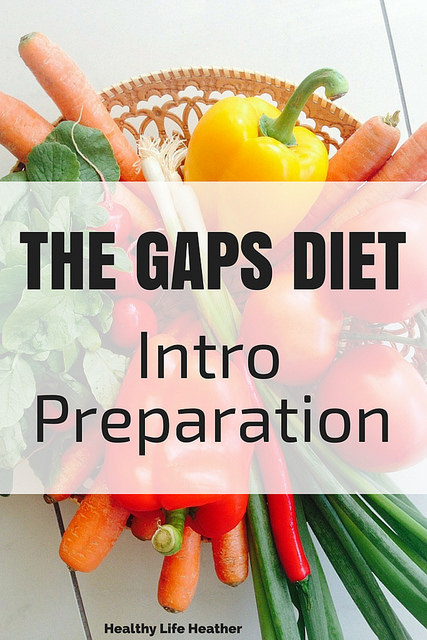
Last summer I started the GAPS diet in an effort to help heal my GI tract.
Before starting GAPS, I compared it to similar diets that offer holistic approaches to treating food sensitivities, digestive issues, and other health concerns. I’m so glad that I spent HOURS reading blogs, locating recipes, and mentally preparing myself for a diet that suggests adhering to it for at least six months. Now that I’ve concluded my GAPS experiment, I want to share my experiences in case my journey can be helpful to someone else.
GAPS diet reading
Before I began the GAPS intro diet on May 23, 2014 I had poured hours of time into reading about the diet in the evenings and on weekends.
Every blog post and article I read highly recommended purchasing Gut and Psychology Syndrome, written by the creator of GAPS Dr. Natasha Campbell-McBride. Although many of the key elements of the diet can be found for free online at The GAPS Diet, I’m glad I ultimately decided to buy the book, as it goes into more detail than any of the GAPS related websites do.
In addition to the official GAPS book, everyone suggested buying What Can I Eat Now? 30 Days of recipes and tips for the GAPS™ Intro Diet from Cara of Health, Home & Happiness. I wondered if I would benefit from the e-book since I had already found GAPS recipes on my own. One day, Cara’s e-book went on sale, and I snatched it up! Reading the recipes and to-do lists made me feel better about my own plan and research. While I did not end up following Cara’s plan (since I’d already developed my own), I can see how helpful the resource would be for someone who doesn’t love to research and plan as much as I do!
The reading prep I enjoyed the most was spending COUNTLESS hours on Pinterest and food blogs, looking for GAPS recipes.
For GAPS (and for my specific pre-existing food issues), recipes had to be free of grains, gluten, dairy, soy, nuts, seeds, legumes, starches, and low in sugar (only raw honey and some fruit allowed). Many paleo and real food bloggers also share GAPS compliant recipes, though some will need a few changes, like swapping out sweet potato (not allowed on GAPS) for butternut squash.
Many of the recipes I pinned are found on these sites — I subscribe to them all and continue to have new recipes delivered to my inbox.
AIP Lifestyle
Grass Fed Girl
Comfy Belly
Fork and Beans
Tasty Yummies
Wellness Mama
Against All Grain
The Paleo Mom
Gutsy
The Urban Poser
Paleo Leap
Plaid and Paleo
Meatified
Savory Lotus
The Well Fed Homestead
Nourished Kitchen
The Healthy Foodie
Detoxinista
Nom Nom Paleo
Empowered Sustenance
Phoenix Helix
Autoimmune Paleo
PaleOMG
Purely Twins
The GAPS intro diet follows six stages, and each new stage allows you to introduce additional foods to your diet. Since vegetables are a huge staple of the diet, preparing meals from scratch can take quite a bit of time with all of the peeling, chopping, slicing and dicing. To save time AND to make sure I was only eating the foods I was allowed at each stage, I copied and pasted the recipes I had pinned into a Word document, being certain to list them by stage.
GAPS diet food preparation
After I found healthy, GAPS compliant recipes and read the GAPS book, I started purchasing and preparing some of the GAPS staples.
GAPS diet and bone broth
First, I sourced beef and chicken bones (from grass fed and pastured animals) so I could make homemade bone broth. Homemade broth is essential to GAPS, and I assumed I would find the best prices online. While I found some good deals, companies required shoppers to purchase much more than I needed, and shipping rates were higher than I liked. Thankfully I soon found three sources of bones in my own backyard! In Charlottesville, I purchased beef bones from The Organic Butcher, JM Stock, and Rebecca’s Natural Food and chicken bones from Rebecca’s. If you can’t find bones locally, the websites I found and compared include US Wellness Meats, Good Earth Farms, Grow and Behold, Slanker’s Grass-fed meats, and KOL Foods.
Chicken bone broth with spaghetti squash, zucchini, carrot, onion, chicken, and basil
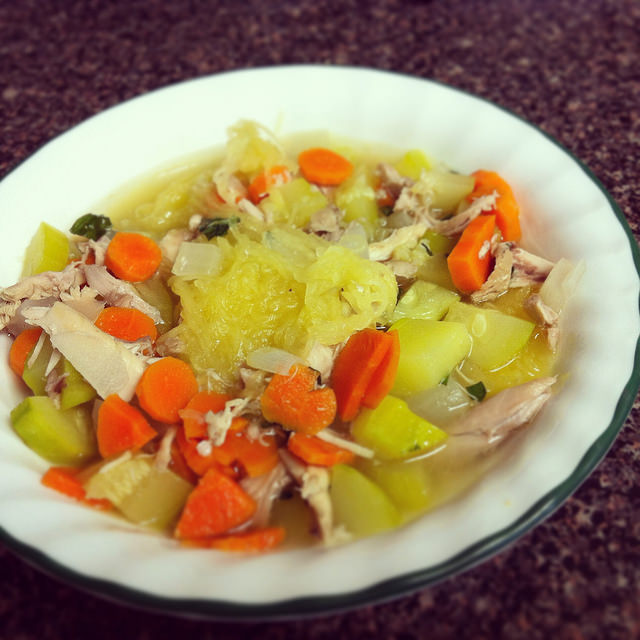
I wanted to make as much broth as possible in a short amount of time, so I borrowed my mom’s crock pot and set it up just beside mine. I made the broth in mid-to-late spring, but the heat from both crock pots made the apartment really warm. I realized if I didn’t make enough in the spring, making it in the high heat and humidity of summer would be miserable!
Once the broth was done, I portioned it into numerous BPA free containers (I used these), labeled them with the type of broth and date, and sent them to my parents who could store the broth in their basement freezer.
While I was preparing the broth, I scouted for other GAPS staples that would be new additions to our kitchen.
GAPS diet and cooking fats
We had been cooking and baking with olive oil and coconut oil exclusively, but animal fats from grass-fed, pastured sources are at the heart of GAPS and the only fats allowed in the early stages (unless you can tolerate ghee, which I chose to skip after not tolerating it well previously). I had come to enjoy eating generous amounts of healthy fats from olive and coconut oil, but I was not excited about adding tallow (beef) or lard (pork) as new fats.
Committed to doing the diet properly, I found tallow from Fatworks at a shop in town (though $20/jar it lasted longer than expected), and I picked up a generous container of leaf lard at JM Stock for just $5. I was nervous that the animals fats would have unhealthy consequences, but all of the reading I’d done suggested that as long as animal fats come from healthy, more natural sources, they provide numerous health benefits.
I’m glad to say that after nine months of cooking with animal fats, I haven’t gained any weight, and aside from my digestive issues, my doctor was very pleased with the results of my other tests. I shouldn’t have been surprised — after all, I didn’t gain weight when I started eating saturated fat from coconut oil (I actually slimmed down!), but I had to mentally overcome years of hearing and believing saturated fats in animals were completely unhealthy. I now really love using them to sauté veggies, wilt spinach, cook burgers, and more! A recent allergy test took all things coconut off of the menu, so at the moment we’re cooking almost exclusively with tallow and leaf lard.
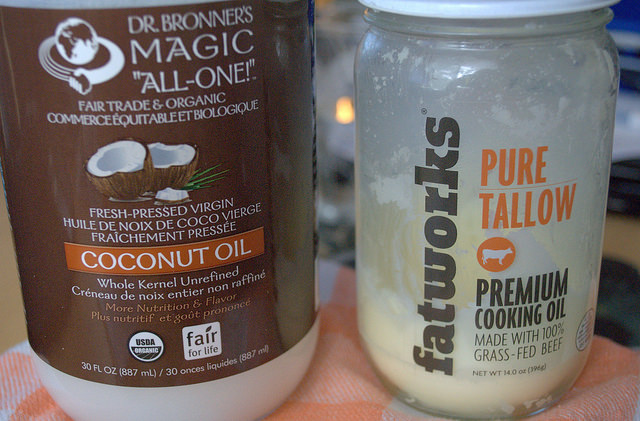
If you’re new to coconut oil, try one of my favorites — Dr. Bronner’s or Nutiva.
GAPS diet and fermented foods
Raw, unpasteurized fermented foods are another GAPS staple and something I’ve never included in my diet. I wasn’t looking forward to adding sauerkraut juice to soup or a few bites of sauerkraut to meals. Instead of preparing my own, I went with another local source! I’m so thankful that Farmstead Ferments exists in my own backyard, and after trying three flavors, I can say without question that the Garlicky Greens is my favorite. This kraut is different than the stuff you’d normally find on the shelf. It tastes and smells soooo much better.
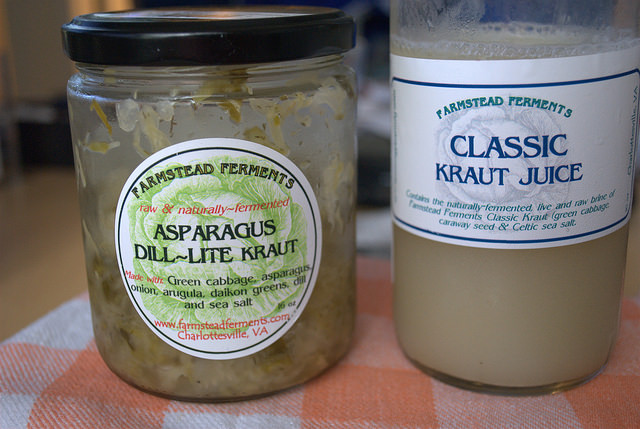
I realize that I am incredibly fortunate to live where I do. We have so many wonderful farmers in Virginia, and I’m able to purchase local grass fed ground beef from pastured cows, pastured chicken, and eggs from pastured chickens who ate non-GMO and non-soy feed.
In the final week leading up to GAPS, my awesome husband peeled and cubed four butternut squash. Two of them were the tallest I’d ever seen. We filled two 1-gallon freezer bags to their max, and whenever I wanted to steam and puree squash in the first few weeks, all I had to do was go to the freezer. We also peeled and chopped enough veggies to get me through the first few days of soups. I highly recommend pre-diet peeling, chopping, and freezing!
In the final days of prep, I also borrowed my parents’ juicer and purchased stainless steel thermoses to carry my soups in for work I bought three of these. Microwaves are not allowed on GAPS, so each morning I had to warm up enough soup for breakfast and for work, and I also carried a small thermos of bone broth to sip between meals.
GAPS diet detox preparation
One of the ways GAPS differs from similar diets is the use of nightly detox baths.
Using the suggestions from the posts on my GAPS info and preparation board, I decided to rotate through adding epsom salts, apple cider vinegar, and baking soda to my baths. Someone recommended fine grain epsom salts from Salt Works, and I still have half of a 25lb bag!
GAPS also suggests reviewing the body care and home cleaning products we use to find the cleanest, least toxic options. I like using the Environmental Working Group’s (EWG) Skin Deep database to compare body care products and am still in the process of swapping out everything from deodorant to shampoo to toothpaste. I’ll write a future post about all of the changes I’ve made!
GAPS diet supplement preparation
Finally, before GAPS started I reviewed the supplements I was currently taking and compared them to the ones Dr. Campbell-McBride recommends. Thankfully I was already taking a probiotic, digestive enzymes, and essential fatty acids (through a fish oil capsule), but I was missing the cod liver oil. I must admit that once I decided on a brand and even located it here in town, I never started taking it. There are so many supplements out there and SO many brands offering the same supplements, it can be difficult to know which ones to choose. I highly recommend working with a naturopath, nutritionist, or integrative/functional medicine practitioner to help decide what’s best for you! I’ve been working with an MD and RD at an integrative medicine practice for eight months and it’s helped tremendously.
What’s next?
I’m so glad I took the time to prepare for GAPS. I found that mentally, I was ready to take on the challenge, and the preparation made the first week easier than expected.
In upcoming GAPS posts I look forward to sharing my experience on the six stages of the intro diet, including successes, missteps, and surprises.
If you’re considering a big diet change, what’s your biggest motivation for taking the plunge? What’s a healthy choice that you’ve made for yourself lately?
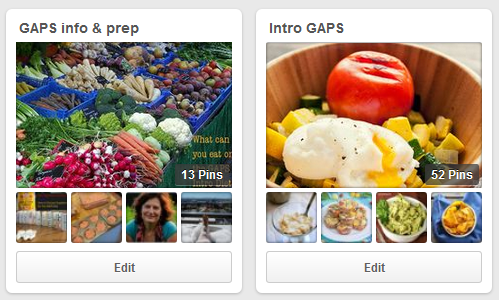
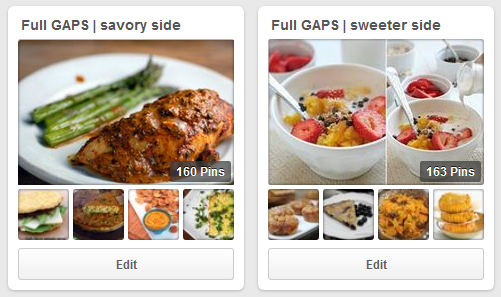
Leave a Reply